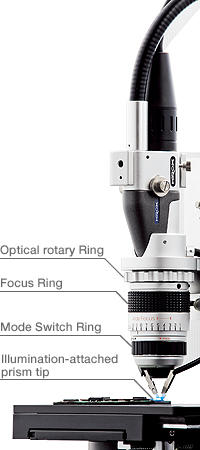
Hirox MX-BGAZii Lens
Hirox MX-BGAZii Lens | Easy & Accurate BGA Exterior Observation
This BGA lens allows ball joints to be observed non-destructively. Also, a 3D optical rotary ring enables 3D observation. This lens incorporates special hardware, such as a prism tip with lighting and a cushion mechanism, to ensure comfortable observation.
Furthermore, observation of the BGA exterior in detail helps specify various problems, such as overheating, oxidation, air foam formation, and their causes. The [MX-BGAZ II] allows inspection of the BGA ball's upper and lower joints by changing the observation angle through the optical rotary ring. This information is useful in reviewing the temperature profiles.
Exterior analysis clearly identifies defects
Exterior observation allows for defect analysis of BGA mounting substrates and the creation of environments for preventing defects. It concentrates HIROX's unique knowledge and technologies for observing BGAs from various angles in an easy manner. The use of this lens allows anybody to become a high-level engineer and to make precise exterior observations.
Optical rotary Ring
Rotating the ring changes observation angles. Without moving the lens and substrates, it enables detailed analysis of upper and lower joint parts of the BGA ball.
Focus Ring
Rotating the ring facilitates focusing on the BGA.
Mode Switch Ring
Rotating the ring switches the observation range without changing the distance from the lens to BGA and allows confirmation of parts warpage and uplift on mounting substrates.
Illumination-attached prism tip
A 45° prism mirror helps view the BGA ball from the side. This prism tip serves the role of a light guide, and enables bright, high-resolution observation even on a concentrated substrate.
This BGA lens allows ball joints to be observed non-destructively. Also, a 3D optical rotary ring enables 3D observation. This lens incorporates special hardware, such as a prism tip with lighting and a cushion mechanism, to ensure comfortable observation.
Furthermore, observation of the BGA exterior in detail helps specify various problems, such as overheating, oxidation, air foam formation, and their causes. The [MX-BGAZ II] allows inspection of the BGA ball's upper and lower joints by changing the observation angle through the optical rotary ring. This information is useful in reviewing the temperature profiles.
Exterior analysis clearly identifies defects
- Because preheating is too long, flux deteriorates and the ball is oxidized and does not melt.
- Detachment caused by outer pressures, detachment from the land because of unfavorable junctions.
- The heat quantity from the upper heater is large, parts are warped, balls are extended & the light halation is out of alignment, coming to the lower part of the ball.
- Because preheating is too long, flux deteriorates & the ball & the solder are not joined into one.
- When light halation is observed at the center of the ball, it indicates that heat balance is favorable & the ball is round-shaped.
- BGA mounting uses light halation as one standard of judgment.
Exterior observation allows for defect analysis of BGA mounting substrates and the creation of environments for preventing defects. It concentrates HIROX's unique knowledge and technologies for observing BGAs from various angles in an easy manner. The use of this lens allows anybody to become a high-level engineer and to make precise exterior observations.
Optical rotary Ring
Rotating the ring changes observation angles. Without moving the lens and substrates, it enables detailed analysis of upper and lower joint parts of the BGA ball.
Focus Ring
Rotating the ring facilitates focusing on the BGA.
Mode Switch Ring
Rotating the ring switches the observation range without changing the distance from the lens to BGA and allows confirmation of parts warpage and uplift on mounting substrates.
Illumination-attached prism tip
A 45° prism mirror helps view the BGA ball from the side. This prism tip serves the role of a light guide, and enables bright, high-resolution observation even on a concentrated substrate.



